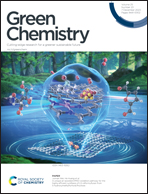Green fabrication of PHBV microbeads using a dimethyl isosorbide solvent for skin exfoliators†
Abstract
Traditional petroleum-based microbeads in personal care products are potentially harmful to the ecological environment and human health due to their non-biodegradability. Thus, it is essential to produce eco-friendly microbeads to replace the traditional ones. In this work, a facile and green method was used to manufacture biodegradable poly(3-hydroxybutyrate-co-3-hydroxyvalerate) (PHBV) microbeads for application in skin exfoliators. The PHBV microbeads were rapidly fabricated via a solvent exchange method wherein dimethyl isosorbide (DMI) acted as a green solvent and a polysorbate 80 aqueous solution was used as the antisolvent. The polymer solution concentration can reach a high of 15 wt%, enabling scalable production. The microbeads were biocompatible and harmless to both plants and aquatic organisms. Moreover, they were degradable in water environments containing microbes yet stable during storage in microbe-free water. Additionally, PHBV microbeads demonstrated excellent skin cleaning efficiency compared to other commercial materials. Therefore, as additives in exfoliation products, these eco-friendly PHBV microbeads have the potential to replace traditional petroleum-based microbeads.



 Please wait while we load your content...
Please wait while we load your content...